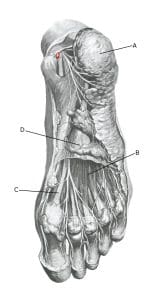Anatomy
A. Corpus adiposum
B. M. flexor digitorum brevis
C. M. flexor hallucis longus
D. Aponeurosis plantaris
See image of ‘heel fat pad syndrome’
Cause of the problem
‘Inflammation’ (inflammation) of the heel pad often occurs after repeated, heavy strain, such as in the landing phase after jumping in gymnastics or running.
Symptoms
Pain when running and walking, especially on hard surfaces. Pain is relieved by walking on toes.
Examination
Diagnosis is usually made by a clinical examination where there is pressure tenderness over the entire fat pad under the heel, including the edges of the fat pad. X-rays and ultrasound scans may be necessary to rule out other diagnoses. Ultrasound scans often show thinning of the heel fat pad (Chang AH, et al. 2022).
Treatment
Treatment primarily involves relief from pain-inducing activity (jumping, running). If treatment is started quickly, the injury can heal in a few weeks in some cases, but symptoms lasting six months are not uncommon. Footwear with an appropriately tight heel cup to keep the heel pad in place under the heel and with shock-absorbing soles is recommended.
Rehabilitation
Treatment primarily consists of relief from pain-inducing activity and slowly increasing load within the pain threshold. The heel pad cannot be trained stronger. The principles during rehabilitation, in general, can be followed until pain-free, after which careful running and jumping can be resumed. Fitness can be maintained by cycling and swimming, among other things.
Bandage
Evidence of the effect of tape on inflammation of the heel pad is scarce, but can be attempted. See tape top side and bottom side heel
Complications
If progress is not smooth, you should reconsider the diagnosis and whether complications have arisen:
In particular, the following should be considered:
Especially
Shock-absorbing shoes and a suitable insole will reduce the risk of heel pad syndrome.

